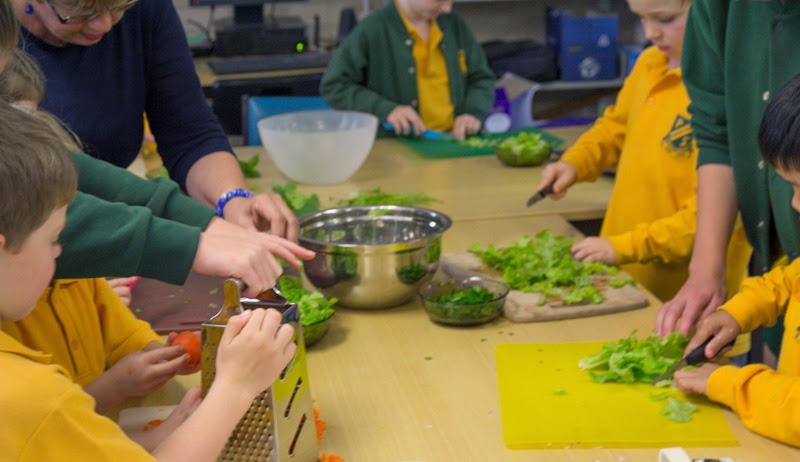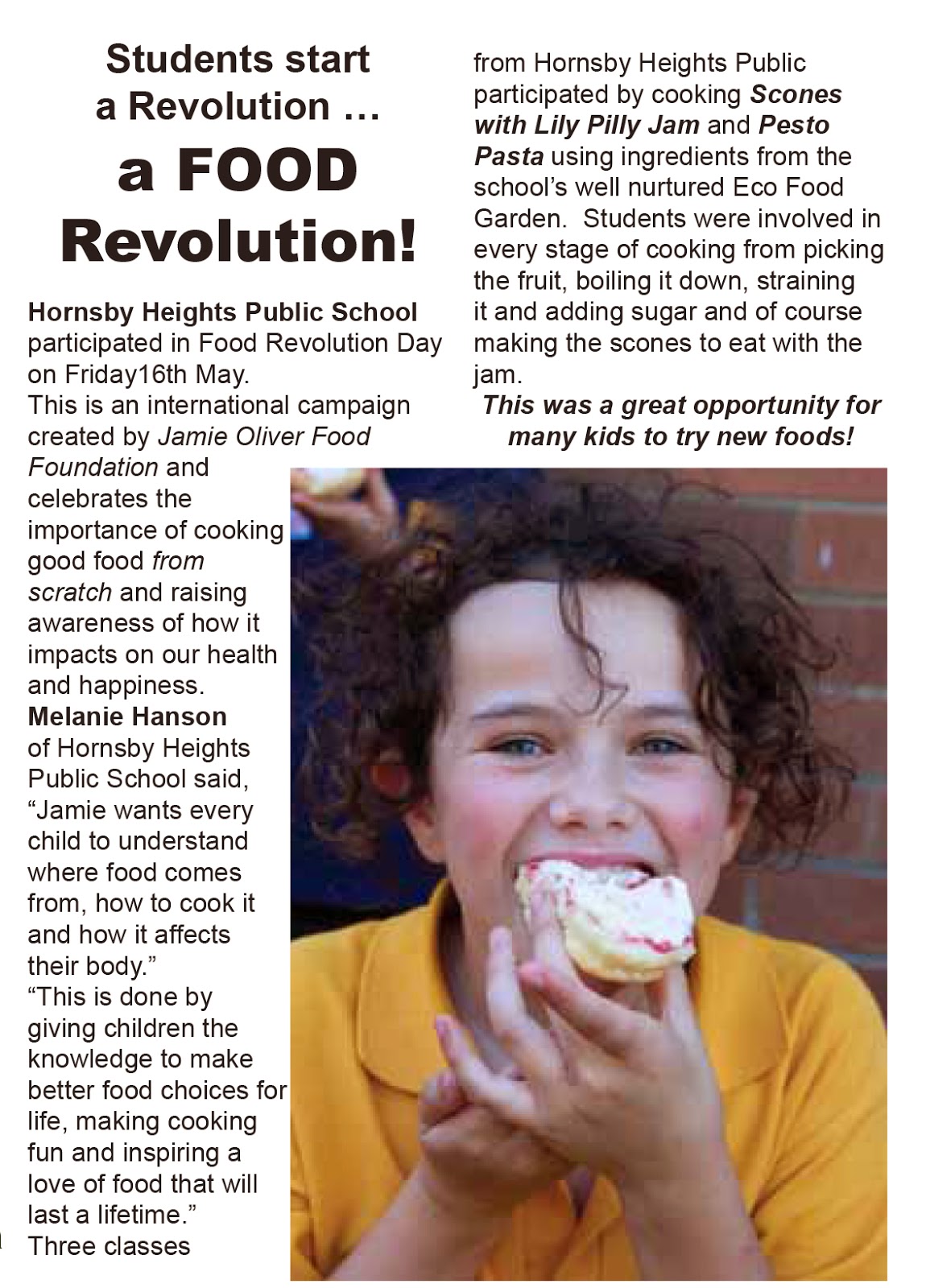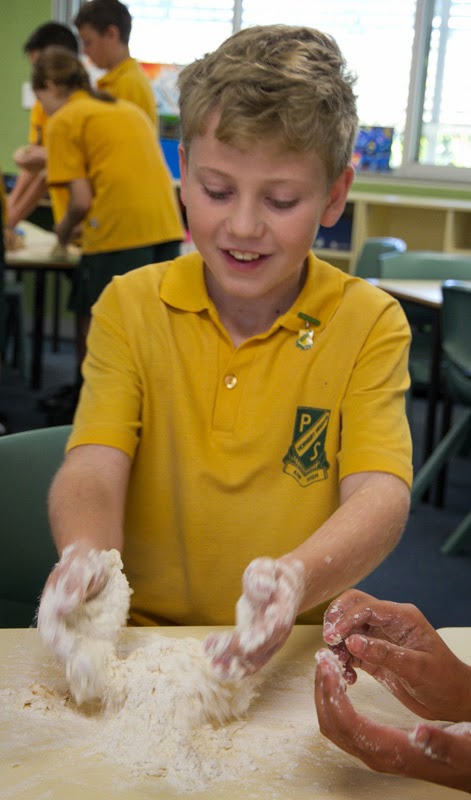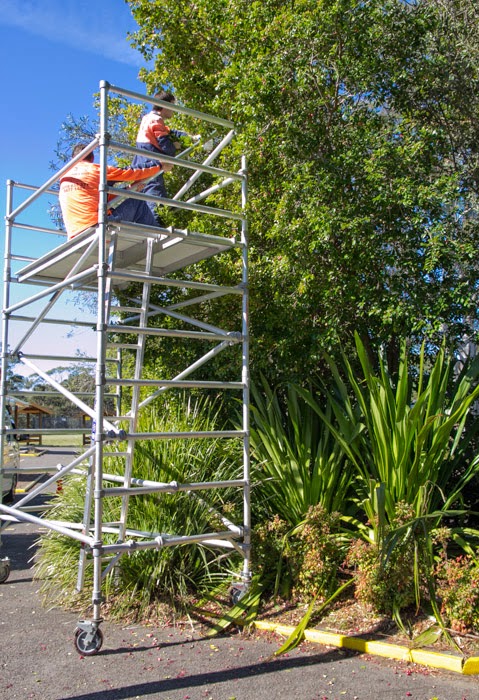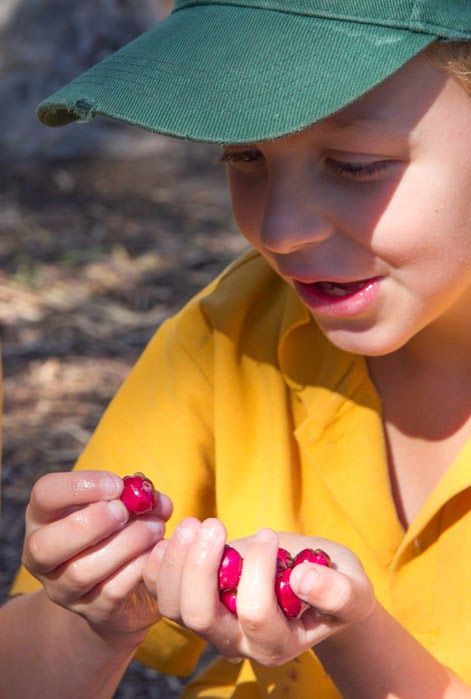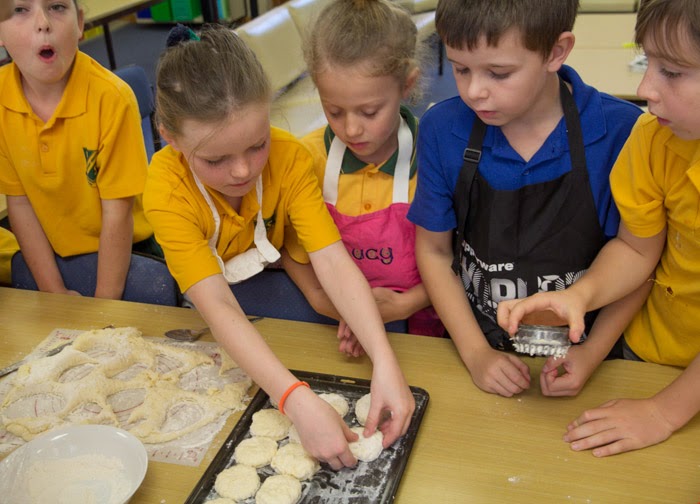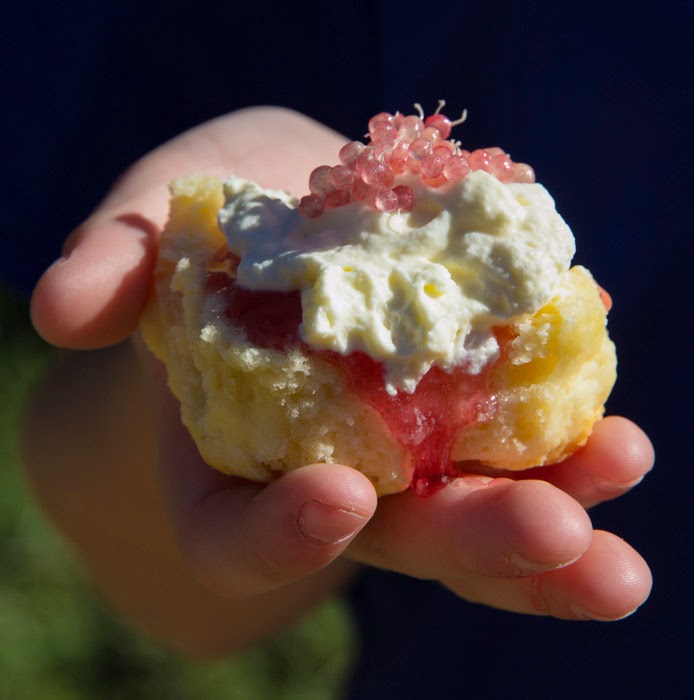Making rice paper rolls with ingredients from the eco garden like radishes, lettuce and herbs.
Friday, May 30, 2014
Thursday, May 29, 2014
Wednesday, May 28, 2014
Friday, May 23, 2014
Lilly Pilly Jelly Recipe
 |
| Lilly Pilly fruit |
Lilly pilly
are native Australian evergreen bushes that produce small white flowers
followed by pink-mauve fruit. Known to some as the Australian cherry, most
people only known them as an attractive shrub. Lilly pilly fruit can harbour
bugs, which is why I prefer to make a ‘jelly’ rather than a ‘jam’- the
difference between jelly and jam is purely the process. Jelly requires
straining to remove the pulp, jam simply uses the whole fruit (except the
seeds).
Lilly Pilly
Jelly is made in 2 steps- ‘juice’ and ‘jelly’. For the best results, do them a
day apart.
 |
| pitted Lilly Pilly fruit |
Ingredients/Materials for the ‘juice’
1-2kg of
lilly pilly fruit, stone removed.
1 large
lemon (or 2 small lemons)
Water
Large
saucepan or soup pan
Muslin
sleeve or jelly bag (or just a doubled over layer of loose weave muslin)
Colander
Large jug
(not a plastic one)
Ingredients/Materials for the ‘jelly’
Fruit
‘juice’
Sugar
Pectin
(Pectin is in most fruit and is a natural gelling/thickening agent. When we
made our jelly, there was sufficient pectin in the fruit for the jelly to set
without needing to add extra. Some fruit have very low levels and will require
commercially bought dried pectin- found near the sugar in most supermarkets.)
Jam jars
Sugar
thermometer
Process - Juice
- Cut the lilly pilly in half to remove the stone then place into a large saucepan or soup pot
- Add sufficient water so that the fruit is just covered by it.
- Slice up the lemon, squeezing the juice into the pot and cutting the rind into chunks before adding. If there are any seeds- these are full of pectin so add them in too!
- Gently simmer the fruit until the liquid has gone the colour of the fruit and the fruit has lost most of its colour (about 15 minutes). Don’t let it boil.
- Sterilise the muslin by boiling it in water for around 5 minutes.
- Place the colander over the jug, then stretch the muslin out over the colander. Make sure it is stable and able to hold the quantity of liquid and fruit in your pot.
- Take the fruit off the heat then gently pour it through the colander. The liquid will pool in the jug leaving the fruit pulp, lemon skin and seeds behind.
- For the best results, leave it in a safe stable position and let it drip overnight. Don’t squeeze the muslin to get out extra juice- this will cloud your final product and may introduce extra bacteria into the mix.
You can store the juice in the fridge
overnight if it has already dripped out. Compost the fruit pulp once it has
finished draining.
 |
| draining the juice from the cooked fruit |
- Place 2-3 small ceramic plates into the freezer- you’ll need these later for the jelly.
- Measure out the amount of juice you have made into the large pan. Don’t put more than 1.5L into the pot of it will bubble over too far. If you have more than that, reserve it and make a second batch.
- For every full cup of juice, add ¾ of a cup of sugar to the pot. (You can modify this amount but the jelly is less likely to set with less sugar.)
- Gently warm the mixture until there are no more sugar granules left on the bottom of the pan.
- While the mixture is warming, wash your jam jars and lids in boiling hot water and place into the oven on a tray. Turn the oven to 110`C and leave them to sterilise.
- Bring the mixture slowly up to a rolling boil. Be careful that the
liquid doesn’t bubble over the pot. It
should take at least 10 minutes to get it to a rolling boil as this lets a
little more water evaporate out. You will need to keep it at a rolling boil for
3 minutes depending on the sugar and pectin content.

boiling juice - When large bubble start forming towards the top of the pot, check the temperature of the mixture with a sugar thermometer. Pectin activates at between 103`C and 105`C and it needs to be in this temperature range for at least 3 minutes to get the pectin & sugar to gel.
- Take out one of your freezer plates. Dribble a
small amount of liquid onto the cold plate, wait 30 seconds then run your
finger through it. If you can see small wrinkles forming when you do so, it is
ready to bottle. If there are no wrinkles, keep boiling for a few minutes more
then repeat.
A. If there are no wrinkles forming after around 8min at a rolling boil, turn the heat down until you just have a liquid. While the mixture is still hot but not bubbling, add pectin (according to the packet instructions) then bring back up to the boil. - When you have wrinkles on your plate, remove the jam from the heat.
- Take the jam jars out of the oven and pour the jam into them. Be careful as both the jars and the jelly is going to be extremely hot! You may want to use a glass or ceramic pourer to get the hot jelly from the pan to the jars.
- Once the bottles are filled almost to the top, put the lids on and let them cool without shaking.
 |
| Lilly Pilly Jelly |
Jars sterilised in this way can last
on the shelf for a few months. Once opened either finish the jelly off within 2
weeks in the cupboard, or refrigerate it to keep it longer.
It is possible to make a sugar-free
(or almost sugar-free) jelly by increasing the pectin levels. The pectin needs
a little bit of sugar to start the binding process but it can be done to a
ratio of 1 cup juice to ¼ cup sugar or even 2 cups juice to ¼ cup sugar. With
so little sugar for the pectin to work with, it won’t bind very well resulting
in a runny end result. Too much pectin can also make ‘gummy’ jelly. Having said
this, less sugar gives a gives a stronger lillypilly flavour. Deliciously tart
with scones or sweet pastry, it won’t keep for long and MUST be refrigerated!
Tuesday, May 20, 2014
Hornsby Advocate
The HHPS Eco Food Garden made it into the Hornsby Advocate:

Using ingredients from the school’s eco-food garden and cooking in the new outdoor kitchen, the year 3 children made scones with lilly pilly jam and the kindergarten class created pesto pasta.
“One of the things he (Jamie Oliver) really encouraged was using an ingredient you haven’t tried before and a lot of the children may never have tried lilly pilly or pesto,” eco-food garden team co-ordinator Rhonda French said.
 Cooking is an activity all the children get to try throughout the year.
Cooking is an activity all the children get to try throughout the year.
“Certainly the parents tell me that kids have requested to make them (the recipes) at home,” Ms French said. “To me that makes it worth it. I love that they get to see the whole cycle — to plant it, water it, pick it and cook it.”
Jamie Oliver’s food revolution day comes to Hornsby Heights Public school

Ruby Roll, Jacob Neve and Scarlet Burge, all five years old, eat pesto pasta they made. Picture: ADAM WARD
Source: News Limited
LESSONS were not only fun but full of flavour for the children at Hornsby Heights Public School on Friday.
Three classes participated in Jamie Oliver’s Food Revolultion Day, a
global day of action to make cooking fun and encourage healthy food
choices.Using ingredients from the school’s eco-food garden and cooking in the new outdoor kitchen, the year 3 children made scones with lilly pilly jam and the kindergarten class created pesto pasta.
“One of the things he (Jamie Oliver) really encouraged was using an ingredient you haven’t tried before and a lot of the children may never have tried lilly pilly or pesto,” eco-food garden team co-ordinator Rhonda French said.

Ryan Browne 9, Jasmine Kelly 8, Franscesco Torrisi 9 and Jessica Whyburn 8, enjoy scones. Picture: ADAM WARD
Source: News Limited
“Certainly the parents tell me that kids have requested to make them (the recipes) at home,” Ms French said. “To me that makes it worth it. I love that they get to see the whole cycle — to plant it, water it, pick it and cook it.”
Friday, May 16, 2014
Jamie Oliver Food Revolution Day
Over two days Year 3 made Lilly Pilly jam and scones to enjoy on Jamie Oliver's Food Revolution Day. Here is the whole journey in pictures:
washing the Lilly Pillies
sorting the good ones from the bad
Taking the pips out of the fruit
finding the odd worm
Look they are edible!
boiling the fruit
straining the boiled fruit through a muslin cloth and getting bright pink red juice
adding sugar and boiling the juice down until it thickens
the finished hot jelly jam
trying the jam which was made with sugar and without
making lemonade scones
cutting out the scones
this is fun!
learning how to cut a scone - there is an art to it!
The final product: scone, Lilly Pilly jam, whipped cream topped with Finger Lime
Year 3 eating their scones
Subscribe to:
Posts (Atom)



